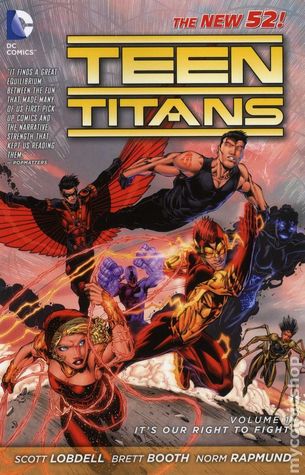Teen Titans Vol. 1: It’s Our Right to Fight (The New 52)
 |
| Superboy was luckily smart enough to dodge the logo. |
Writer: Scott
Lobdell
Artists: Brett
Booth and Norm Rapmund
Collects: Teen Titans #1-7
Background
Information:
Who would have guessed that a comic featuring all of the
sidekicks from the DC universe would take off in such a big way?
Yet ever since the 80s, the Teen Titans have continued to
pull a major readership. In recent years, the team roster has changed a lot,
but DC seemed to have settled on four major characters that are always on the
team: Robin, Superboy, Kid Flash and Wondergirl.
Review:
 Not surprisingly, the New 52’s Teen Titans takes a lot of cues from the now-cancelled Young Justice cartoon. This is a darker
setting than those used to the Teen
Titans cartoon of last decade are accustomed to. Yet, while Young Justice made their roster of
teenage sidekicks take on a life of their own, Lobdell’s take on Teen Titans fails to take advantage of a
great group dynamic and ultimately, this book comes across as little more than
a poor-man’s Justice League.
Not surprisingly, the New 52’s Teen Titans takes a lot of cues from the now-cancelled Young Justice cartoon. This is a darker
setting than those used to the Teen
Titans cartoon of last decade are accustomed to. Yet, while Young Justice made their roster of
teenage sidekicks take on a life of their own, Lobdell’s take on Teen Titans fails to take advantage of a
great group dynamic and ultimately, this book comes across as little more than
a poor-man’s Justice League.
It’s Our Right to
Fight’s plot follows a very X-Men like structure. All over the world,
teenage “meta-humans” are popping up and making themselves known. A shadowy
organisation called N.O.W.H.E.R.E , which has possibly the most complicated
acronym ever, are after all of them for shadowy reasons. Enter Tim Drake, a.k.a
Red Robin, whose goal it is to gather all of the meta-teens he can to resist
N.O.W.H.E.R.E and their ambiguous attacks. As Drake puts this team together,
N.O.W.H.E.R.E releases their counter-measure to try and stop Drake and his new
friends: the test-tube meta-teen Superboy.
I should make it very clear here, that only Red Robin ever
admits to having been a superhero’s sidekick. The other characters have pretty
much sprung up out of nowhere. And that’s fine. In fact, the team dynamic is
strong in Teen Titans. As a group,
they work together better than Geoff John’s Justice
League did on their first outing. Most of the characters have strong,
distinct personalities, as well. Kid Flash is cocky and arrogant, Skitter
(cross between the Hulk and a weird bug creature), is militantly uninterested
in joining a team, and Wondergirl is brash and headstrong. The only weakness in
the characterisation here is Bunker, the gay Mexican who somehow manages to
embody every cliché connected to both minorities. Go figure, the guy who wears
and wields purple stuff is the gay character. Bunker also refers to himself as
“fabulous” and dresses like a fashion designer. He uses Spanish interchangeably
with English while seeming to assume everyone knows what he’s talking about,
and regularly mentions how much his small Mexican village is nothing compared
to American cities. Lobdell thankfully salvages the character by making him the
glue that keeps the team together, but were it not for that, Bunker would be a
step backward for comic diversity.
But Bunker isn’t the real problem for the Teen Titans.
Lobdell’s written some excellent character here and they definitely have
potential, but his poor choice of story content hurts what could otherwise be
an amazing collection. Throughout this volume’s seven issues, it feels like
very little actually happens. It’s a problem that isn’t made better by the
book’s non-ending that leads right into The
Culling crossover event, which left me feeling like I had given up on the
series after reading a few issues.
 The art here is not bad by any means. Booth manages to
capture the emotions of the Teen Titans perfectly and Rapmund’s inks are
impressive. The problem, though, is that Teen
Titans ends up looking like every other DC book on the market. Some really
stand-out art with its own unique style might have served to compensate for a
storyline that felt rather pointless. Unfortunately, even with really good
sameness, the art in It’s Our Right to
Fight failed to distract me from the fact that I just wanted the Teen
Titans to take those great personalities and that amazing team dynamic and do
something more interesting with it.
The art here is not bad by any means. Booth manages to
capture the emotions of the Teen Titans perfectly and Rapmund’s inks are
impressive. The problem, though, is that Teen
Titans ends up looking like every other DC book on the market. Some really
stand-out art with its own unique style might have served to compensate for a
storyline that felt rather pointless. Unfortunately, even with really good
sameness, the art in It’s Our Right to
Fight failed to distract me from the fact that I just wanted the Teen
Titans to take those great personalities and that amazing team dynamic and do
something more interesting with it.
Ultimately, though, it’s about as hard to recommend It’s Our Right to Fight as it is to
completely discredit it. Lobdell has made a great team here, but it’s a team
who seems to be doing very little. This collection gets a two and a half out of
five gay stereotypes.
+ Amazing team dynamic
+ Very likeable characters
- Not much happens
- Bunker relies on
too many stereotypes.
Alternate Option: Justice League: Origin
As much as many have loved to beat this story up, I still
found myself enjoying it more than It’s
Our Right to Fight.

No comments:
Post a Comment